Intro: How to use this book
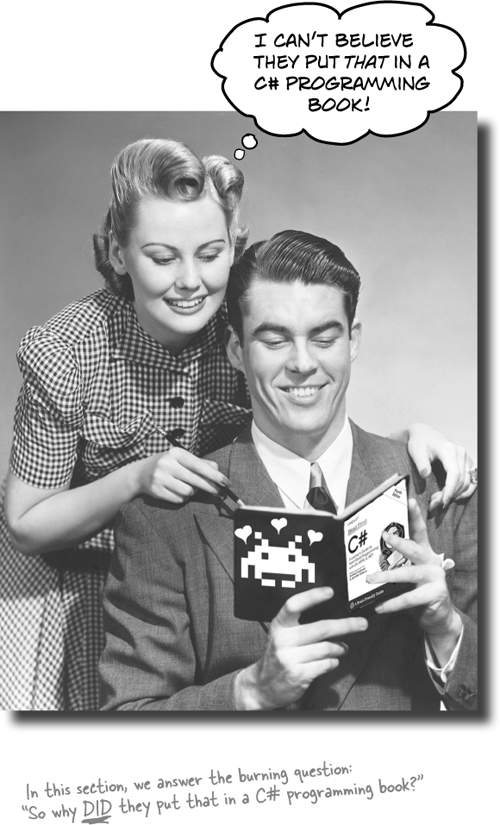
Who is this book for?
If you can answer “yes” to all of these:
Do you want to learn C# (and pick up some knowledge of game development and Unity along the way)?
Do you like to tinker? Do you learn by doing, rather than just reading?
Do you prefer interesting and stimulating conversation to dry, dull, academic lectures?
this book is for you.
Who should probably avoid this book?
If you can answer “yes” to any of these:
Are you more interested in theory than practice?
Does the idea of doing projects and writing code make you bored and a little twitchy?
Are you afraid to try something different? Do you think a book about serious topic like development needs to be serious all the time?
you might consider trying another book first.
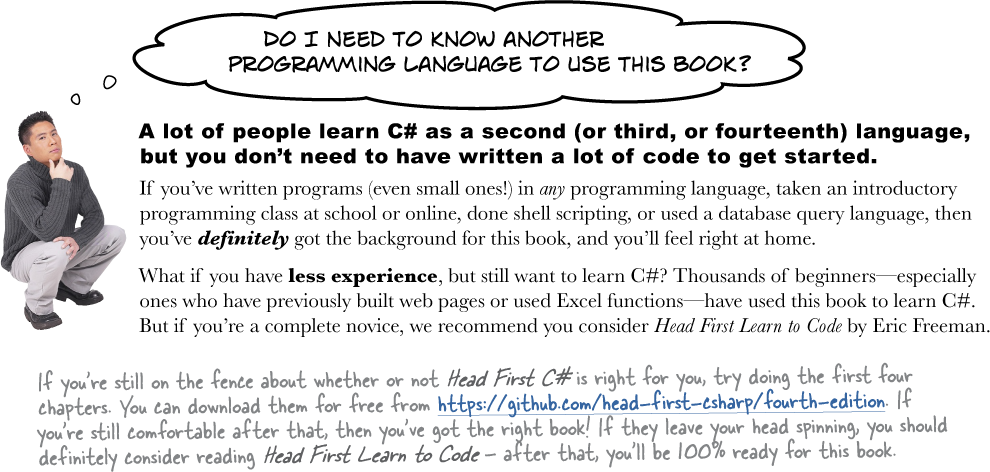
We know what you’re thinking.
“How can this be a serious C# programming book?”
“What’s with all the graphics?”
“Can I actually learn it this way?”
And we know what your brain is thinking.
Your brain craves novelty. It’s always searching, scanning, waiting for something unusual. It was built that way, and it helps you stay alive.
So what does your brain do with all the routine, ordinary, normal things you encounter? Everything it can to stop them from interfering with the brain’s real job—recording things that matter. It doesn’t bother saving the boring things; they never make it past the “this is obviously not important” filter.
How does your brain know what’s important? Suppose you’re out for a day hike and a tiger jumps out in front of you. What happens inside your head and body?
Neurons fire. Emotions crank up. Chemicals surge.
And that’s how your brain knows…
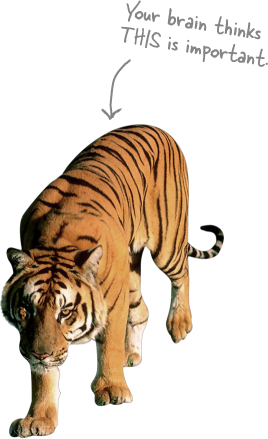
This must be important! Don’t forget it!
But imagine you’re at home, or in a library. It’s a safe, warm, tiger-free zone. You’re studying. Getting ready for an exam. Or trying to learn some tough technical topic your boss thinks will take a week, ten days at the most.
Just one problem. Your brain’s trying to do you a big favor. It’s trying to make sure that this obviously unimportant content doesn’t clutter up scarce resources. Resources that are better spent storing the really big things. Like tigers. Like the danger of fire. Like how you should never have posted those “party” photos on your Facebook page.
And there’s no simple way to tell your brain, “Hey brain, thank you very much, but no matter how dull this book is, and how little I’m registering on the emotional Richter scale right now, I really do want you to keep this stuff around.”

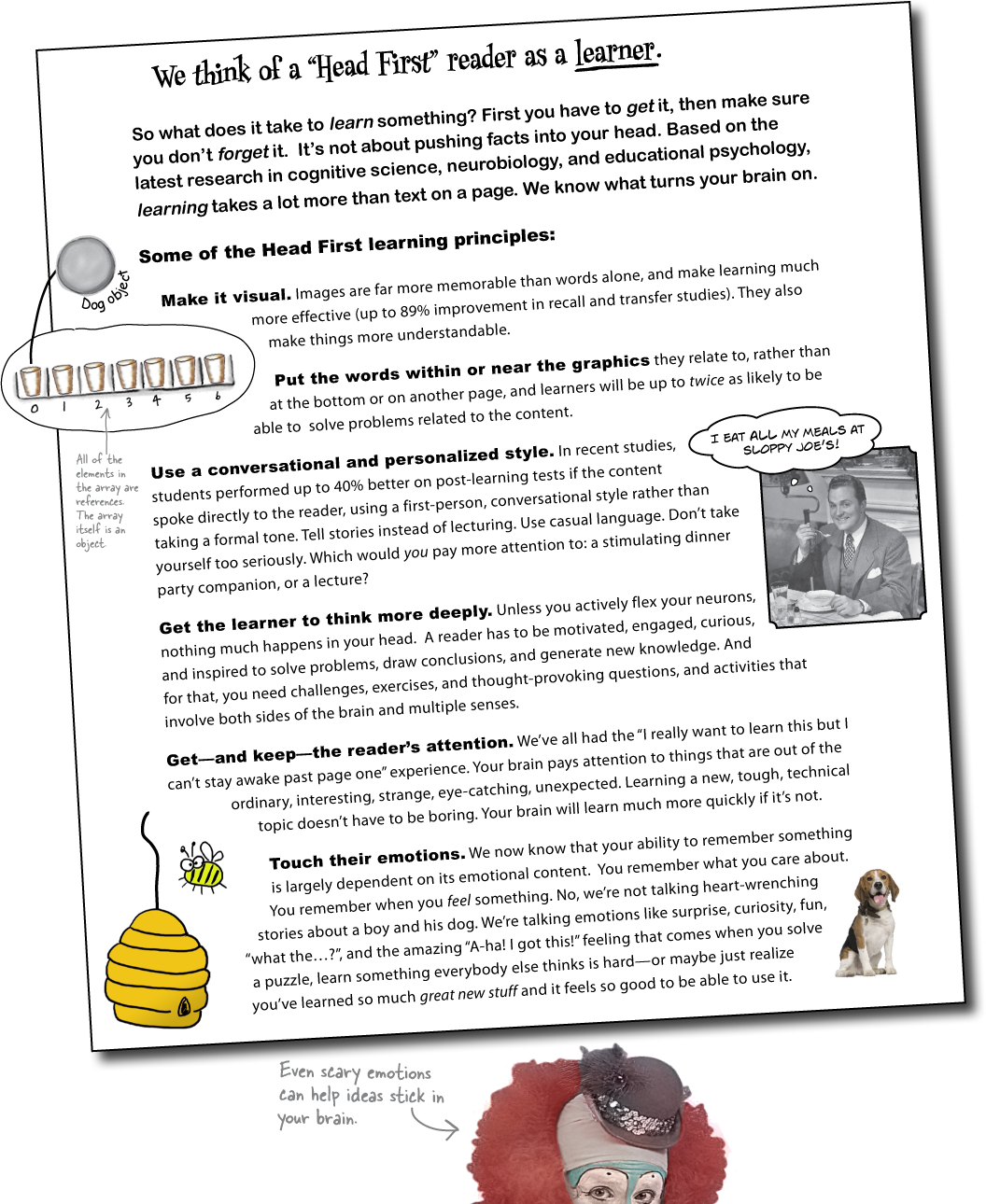
Metacognition: thinking about thinking
If you really want to learn, and you want to learn more quickly and more deeply, pay attention to how you pay attention. Think about how you think. Learn how you learn.
Most of us did not take courses on metacognition or learning theory when we were growing up. We were expected to learn, but rarely taught to learn.
But we assume that if you’re holding this book, you really want to learn how to build programs in C#. And you probably don’t want to spend a lot of time on it. If you want to use what you read in this book, you need to remember what you read. And for that, you’ve got to understand it. To get the most from this book, or any book or learning experience, take responsibility for your brain. Your brain on this content.
The trick is to get your brain to see the new material you’re learning as Really Important. Crucial to your well-being. As important as a tiger. Otherwise, you’re in for a constant battle, with your brain doing its best to keep the new content from sticking.

So just how DO you get your brain to treat C# like it was a hungry tiger?
There’s the slow, tedious way, or the faster, more effective way. The slow way is about sheer repetition. You obviously know that you are able to learn and remember even the dullest of topics if you keep pounding the same thing into your brain. With enough repetition, your brain says, “This doesn’t feel important, but they keep looking at the same thing over and over and over, so I suppose it must be.”
The faster way is to do anything that increases brain activity, especially different types of brain activity. The things on the previous page are a big part of the solution, and they’re all things that have been proven to help your brain work in your favor. For example, studies show that putting words within the pictures they describe (as opposed to somewhere else on the page, like in a caption or in the body text) causes your brain to try to make sense of how the words and pictures relate, and this causes more neurons to fire. More neurons firing = more chances for your brain to get that this is something worth paying attention to, and possibly recording.
A conversational style helps because people tend to pay more attention when they perceive that they’re in a conversation, since they’re expected to follow along and hold up their end. The amazing thing is, your brain doesn’t necessarily care that the “conversation” is between you and a book! On the other hand, if the writing style is formal and dry, your brain perceives it the same way you experience being lectured to while sitting in a roomful of passive attendees. No need to stay awake.
But pictures and conversational style are just the beginning.
Here’s what WE did
We used pictures, because your brain is tuned for visuals, not text. As far as your brain’s concerned, a picture really is worth a thousand words. And when text and pictures work together, we embedded the text in the pictures because your brain works more effectively when the text is within the thing the text refers to, as opposed to in a caption or buried in the text somewhere.
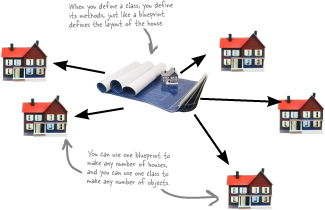
We used redundancy, saying the same thing in different ways and with different media types, and multiple senses, to increase the chance that the content gets coded into more than one area of your brain.
We used concepts and pictures in unexpected ways because your brain is tuned for novelty, and we used pictures and ideas with at least some emotional content, because your brain is tuned to pay attention to the biochemistry of emotions. That which causes you to feel something is more likely to be remembered, even if that feeling is nothing more than a little humor, surprise, or interest.
We used a personalized, conversational style, because your brain is tuned to pay more attention when it believes you’re in a conversation than if it thinks you’re passively listening to a presentation. Your brain does this even when you’re reading.
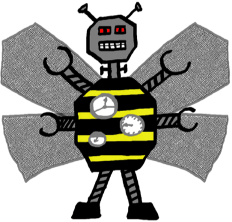
We included dozens of activities, because your brain is tuned to learn and remember more when you do things than when you read about things. And we made the paper puzzles and code exercises challenging yet doable, because that’s what most people prefer.
We used multiple learning styles, because you might prefer step-by-step procedures, while someone else wants to understand the big picture first, and someone else just wants to see an example. But regardless of your own learning preference, everyone benefits from seeing the same content represented in multiple ways.

We included content for both sides of your brain, because the more of your brain you engage, the more likely you are to learn and remember, and the longer you can stay focused. Since working one side of the brain often means giving the other side a chance to rest, you can be more productive at learning for a longer period of time.
And we included stories and exercises that present more than one point of view, because your brain is tuned to learn more deeply when it’s forced to make evaluations and judgments.
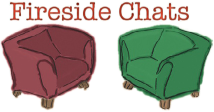
We included challenges, with exercises, and asked questions that don’t always have a straight answer, because your brain is tuned to learn and remember when it has to work at something. Think about it—you can’t get your body in shape just by watching people at the gym. But we did our best to make sure that when you’re working hard, it’s on the right things. That you’re not spending one extra dendrite processing a hard-to-understand example, or parsing difficult, jargon-laden, or overly terse text.
We used people. In stories, examples, pictures, etc., because, well, because you’re a person. And your brain pays more attention to people than it does to things.

Here’s what YOU can do to bend your brain into submission
So, we did our part. The rest is up to you. These tips are a starting point; listen to your brain and figure out what works for you and what doesn’t. Try new things.

Note
Cut this out and stick it on your refrigerator.
Slow down. The more you understand, the less you have to memorize.
Don’t just read. Stop and think. When the book asks you a question, don’t just skip to the answer. Imagine that someone really is asking the question. The more deeply you force your brain to think, the better chance you have of learning and remembering.
Do the exercises. Write your own notes.
We put them in, but if we did them for you, that would be like having someone else do your workouts for you. And don’t just look at the exercises. Use a pencil. There’s plenty of evidence that physical activity while learning can increase the learning.
Read the “There are no Dumb Questions” sections.
That means all of them. They’re not optional sidebars—they’re part of the core content! Don’t skip them.
Make this the last thing you read before bed. Or at least the last challenging thing.
Part of the learning (especially the transfer to long-term memory) happens after you put the book down. Your brain needs time on its own, to do more processing. If you put in something new during that processing time, some of what you just learned will be lost.
Drink water. Lots of it.
Your brain works best in a nice bath of fluid. Dehydration (which can happen before you ever feel thirsty) decreases cognitive function.
Talk about it. Out loud.
Speaking activates a different part of the brain. If you’re trying to understand something, or increase your chance of remembering it later, say it out loud. Better still, try to explain it out loud to someone else. You’ll learn more quickly, and you might uncover ideas you hadn’t known were there when you were reading about it.
Listen to your brain.
Pay attention to whether your brain is getting overloaded. If you find yourself starting to skim the surface or forget what you just read, it’s time for a break. Once you go past a certain point, you won’t learn faster by trying to shove more in, and you might even hurt the process.
Feel something.
Your brain needs to know that this matters. Get involved with the stories. Make up your own captions for the photos. Groaning over a bad joke is still better than feeling nothing at all.
Write a lot of code!
There’s only one way to really learn C# so it sticks: write a lot of code. And that’s what you’re going to do throughout this book. Coding is a skill, and the only way to get good at it is to practice. We’re going to give you a lot of practice: every chapter has exercises that pose a problem for you to solve. Don’t just skip over them—a lot of the learning happens when you solve the exercises. If you get stuck, don’t be afraid to peek at the solution! We included a solution to each exercise for a reason: it’s easy to get snagged on something small. But try to solve the problem before you look at the solution. And definitely get it working before you move on to the next part of the book.
README
This is a learning experience, not a reference book. We deliberately stripped out everything that might get in the way of learning whatever it is we’re working on at that point in the book. And the first time through, you need to begin at the beginning, because the book makes assumptions about what you’ve already seen and learned.
The activities are NOT optional.
The puzzles and activities are not add-ons; they’re part of the core content of the book. Some of them are to help with memory, some for understanding, and some to help you apply what you’ve learned. Don’t skip the written problems. The pool puzzles are the only things you don’t have to do, but they’re good for giving your brain a chance to think about twisty little logic puzzles—and they’re definitely a great way to really speed up the learning process.
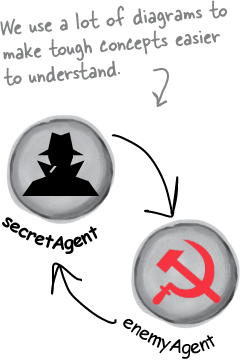
The redundancy is intentional and important.
One distinct difference in a Head First book is that we want you to really get it. And we want you to finish the book remembering what you’ve learned. Most reference books don’t have retention and recall as a goal, but this book is about learning, so you’ll see some of the same concepts come up more than once.
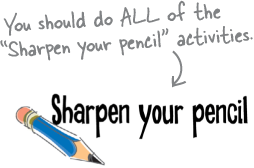
Do all the exercises!
The one big assumption that we made when we wrote this book is that you want to learn how to program in C#. So we know you want to get your hands dirty right away, and dig right into the code. We gave you a lot of opportunities to sharpen your skills by putting exercises in every chapter. We’ve labeled some of them “Do this!”—when you see that, it means that we’ll walk you through all of the steps to solve a particular problem. But when you see the Exercise logo with the running shoes, then we’ve left a big portion of the problem up to you to solve, and we gave you the solution that we came up with. Don’t be afraid to peek at the solution—it’s not cheating! But you’ll learn the most if you try to solve the problem first.
We’ve also included all the exercise solutions source code with the rest of the code from this book. You can find all of it on our GitHub page: https://github.com/head-first-csharp/fourth-edition.
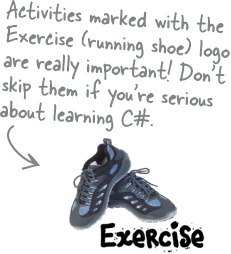
The “Brain Power” questions don’t have answers.
For some of them, there is no right answer, and for others, part of the learning experience is for you to decide if and when your answers are right. In some of the Brain Power questions you will find hints to point you in the right direction.
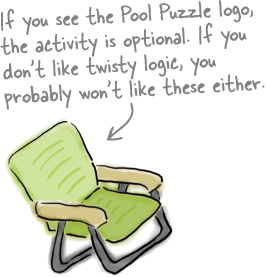
We’re targeting C# 8.0, Visual Studio 2019, and Visual Studio 2019 for Mac.
This book is all about helping you learn C#. The team at Microsoft that develops and maintains C# releases updates to the language. C# 8.0 is the current version at the time this book is going to into production. We also lean very heavily on Visual Studio, Microsoft’s integrated development environment (IDE), as a tool for learning, teaching, and exploring C#. The screenshots in this book were taken with the latest versions of Visual Studio 2019 and Visual Studio 2019 for Mac available at the time of production. We included instructions for installing Visual Studio in #start_building_with_chash_build_somethin, and for installing Visual Studio for Mac in the Visual Studio for Mac Learner’s Guide appendix.
We’re on the cusp of C# 9.0, which will be released not long after this book comes out. It has some great new features! The features of C# that are part of the core learning in this book will be unchanged, so you will be able to use this book with future versions of C#. The Microsoft teams that maintain Visual Studio and Visual Studio for Mac routinely release updates, and very rarely those changes will affect screenshots in this book.
The Unity Lab sections in this book target Unity 2020.1, the latest version of Unity available as this book is going into production. We included instructions for installing Unity in the first Unity Lab.
The technical review team

Lisa Kellner

Lindsey Bieda

Tatiana Mac

Ashley Godbold
Not pictured (but just as amazing) are the reviewers from the third and second editions: Rebeca Dunn-Krahn, Chris Burrows, Johnny Halife, and David Sterling.
And from the first edition: Jay Hilyard, Daniel Kinnaer, Aayam Singh, Theodore Casser, Andy Parker, Peter Ritchie, Krishna Pala, Bill Meitelski, Wayne Bradney, Dave Murdoch, and especially Bridgette Julie Landers
And super special thanks to our wonderful readers—especially Alan Ouellette, Jeff Counts, Terry Graham, Sergei Kulagin, Willian Piva, Jim Cupec, Mike Olgren, David Horvitz, and Greg Combow—who let us know about issues that they found while reading our book, and professor Joe Varrasso at Mohawk College for being an early adopter of our book for his course.
Thank you all so much!!
“If I have seen further it is by standing on the shoulders of Giants.” – Isaac Newton
The book you’re reading has very few errors in it, and we give a TON of credit for its high quality to our amazing team of technical reviewers—the giants who kindly lent us their shoulders. To the review team: we’re so incredibly grateful for the work that you all did for this book. Thank you so much!
Lindsey Bieda is a software engineer living in Pittsburgh, PA. She owns more keyboards than any human probably should. When she’s not coding she’s hanging out with her cat, Dash, and drinking tea. Her projects and ramblings can be found at rarlindseysmash.com.
Tatiana Mac is an independent American engineer who works directly with organizations to build clear and coherent products and design systems. She believes the trifecta of accessibility, performance, and inclusion can work symbiotically to improve our social landscape digitally and physically. When ethically minded, she thinks technologists can dismantle exclusionary systems in favor of community-focused, inclusive ones.
Note
We totally agree with Tatiana on this!
Dr. Ashley Godbold is a programmer, game designer, author, artist, mathematician, teacher, and mom. She works full-time as a software engineering coach at a major retailer and also runs a small indie video game studio, Mouse Potato Games. She is a Unity Certified Instructor and teaches college courses in computer science, mathematics, and game development. She has written Mastering Unity 2D Game Development (2nd Edition) and Mastering UI Development with Unity, as well as created video courses entitled 2D Game Programming in Unity and Getting Started with Unity 2D Game Development.
And we really want to thank Lisa Kellner—this is the 12th (!!!) book that she’s reviewed for us. Thank you so much!
We also want to give special thanks to Joe Albahari and Jon Skeet for their incredible technical guidance and really careful and thoughtful review of the first edition, which truly set us up for the success we’ve had with this book over the years. We benefited so much from your input—even more, in fact, than we realized at the time.
Acknowledgments
Our editor:
First and foremost, we want to thank our amazing editor, Nicole Taché, for everything you’ve done for this book. You did so much to help us get it out the door, and gave a ton of incredible feedback. Thank you so much!
Nicole Taché
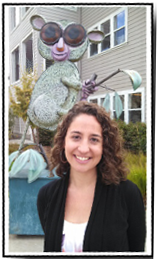
The O’Reilly team:
Katherine Tozer

There are so many people at O’Reilly we want to thank that we hope we don’t forget anyone. First, last, and always, we we want to thank Mary Treseler, who’s been with us on our journey with O’Reilly from the very beginning. Special thanks to production editor Katherine Tozer, indexer Joanne Sprott, and Rachel Head for her sharp proofread—all of whom helped get this book from production to press in record time. A huge and heartfelt thanks to Amanda Quinn, Olivia MacDonald, and Melissa Duffield for being instrumental in getting this whole project on track. And a big shout-out to our other friends at O’Reilly: Andy Oram, Jeff Bleiel, Mike Hendrickson, and, of course, Tim O’Reilly. If you’re reading this book right now, then you can thank the best publicity team in the industry: Marsee Henon, Kathryn Barrett, and the rest of the wonderful folks at Sebastopol.
And we want to give a shout-out to some of our favorite O’Reilly authors:
Dr. Paris Buttfield-Addison, Jon Manning, and Tim Nugent, whose book Unity Game Development Cookbook is just simply amazing. We’re eagerly looking forward to Head First Swift from Paris and Jon.
Joseph Albahari and Eric Johannsen, who wrote the thoroughly indispensable C# 8.0 in a Nutshell.
And finally...
Thank you so much to Cathy Vice of Indie Gamer Chick fame for her amazing piece on epilepsy that we used in #reading_and_writing_files_save_the_last, and for fighting the good fight for epilepsy advocacy. And takk skal du ha to Patricia Aas for her phenomenal video on learning C# as a second language that we use in our Code Kata appendix, and for her feedback on how to help advanced learners use this book.
Jon Galloway

And an enormous thank you to our friends at Microsoft who helped us so much with this book—your support through this project was amazing. We’re so grateful to Dominic Nahous (congratulations on the baby!), Jordan Matthiesen, and John Miller from the Visual Studio for Mac team, and to Cody Beyer, who was instrumental in getting our whole partnership with that team started. Thank you to David Sterling for an awesome review of the third edition, and Immo Landwerth for helping us nail down the topics we should cover in this edition. Extra special thanks to Mads Torgersen, Program Manager for the C# language, for all the wonderful guidance and advice he’s given us over the years. You all are fantastic.
We’re especially grateful to Jon Galloway, who provided so much amazing code for the Blazor projects throughout the book. Jon is a senior program manager on the .NET Community Team. He’s coauthored several books on .NET, helps run the .NET Community Standups, and cohosts the Herding Code podcast. Thank you so much!
O’Reilly online learning

For more than 40 years, O’Reilly Media has provided technology and business training, knowledge, and insight to help companies succeed.
Our unique network of experts and innovators share their knowledge and expertise through books, articles, and our online learning platform. O’Reilly’s online learning platform gives you on-demand access to live training courses, in-depth learning paths, interactive coding environments, and a vast collection of text and video from O’Reilly and 200+ other publishers. For more information, visit http://oreilly.com.
Get Head First C#, 4th Edition now with the O’Reilly learning platform.
O’Reilly members experience books, live events, courses curated by job role, and more from O’Reilly and nearly 200 top publishers.

